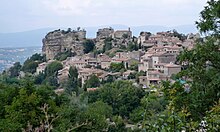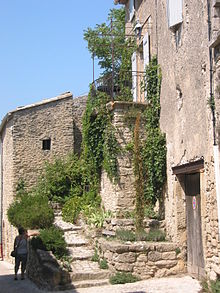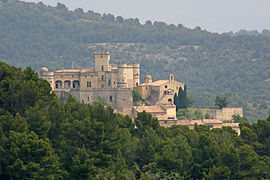73:'Villages perchés' are found mainly in hilly areas where soil is poor and water scarce. This is generally case in Provence except in the lower Rhone valley and in the Durance valley, where alluvial land abounds and water is easily accessible from a well dug in the courtyard of the house. Moreover, this grouping in a community closed in on itself corresponds to regions of small properties, where the only fertile lands are situated at the bottom of a few valleys, and this aggregation has facilitated the existence of rural handicraft indispensable to the villagers. Conversely, the dispersed habitat implies larger, wealthier estates, hence the aphorism penned by Fernand Benoit: "Poverty concentrates the habitat, wealth disperses it".
121:
including attic with its outer pulley to hoist the forage. Currently, the only possible transformations - these houses having lost their agricultural status - are to install a garage on the ground floor and create new rooms in the attic. For those houses restored with taste, the floor of the habitation is reached by a staircase joined to the facade. The presence of terrace or balcony was constant. The terrace was used primarily for the drying of fruit and vegetables suspended from a wire called a 'trihard' when forming a trellis that covered a rustic
171:
156:
17:
201:
186:
141:
64:
82:
47:. The villages, situated on their "rocky acropolis", have retained their medieval appearance, from the orientation of the facades of their houses - towards the valley or the road of communication - a true front of fortification. Fernand Benoit emphasizes their occasional prehistoric origin by pointing out that
92:
There is a specific habitat type that is linked to the village perché: the 'high house'. Benoit explains that "its originality consists in placing the beasts below, man above." The building is subdivided into a barn on the ground floor, housing on one or two floors, and an attic. It was the type of
120:
Indeed, this type of dwelling, gathering people and animals in a village, could only remain frozen in time, any extension being impossible except vertically. Their architecture is therefore characteristic: a narrow facade with one or two windows, and an elevation not exceeding four to five floors,
117:. Most of these houses date from the 16th century, when the religious wars forced the populace to hide behind the village fortifications. When the wars were over, there was a drift to the periphery of the agglomeration and "houses on land", more able to accommodate annexed buildings.
93:
house reserved for the peasant villagers who had little livestock to accommodate. It is still found today in a number of mountainous massifs of western
Provence, including the Alps valleys of
35:, most commonly found in France. Naturally difficult to access, often with ramparts, 'villages perchés' are for the most part fortified settlements dating from the
245:
40:
170:
102:
264:
110:
191:
155:
32:
241:
200:
129:, columns supporting a canopy covered with tiles, it was called a 'galarié' or 'soulerie'.
185:
140:
16:
258:
98:
36:
206:
161:
94:
86:
44:
63:
176:
146:
122:
114:
81:
20:
51:, in reference to the Ligurians who inhabited the region, called them
126:
67:
48:
238:
La
Provence et le Comtat Venaissin, Arts et traditions populaires.
106:
80:
62:
15:
39:. Many are located in the south-east of France in the present
55:, inhabitants of the castellas (Brutus, LXXIII, 256).
43:region, this type of habitat considered typical of
101:, in the mountain of Lure where it is common in
8:
232:
230:
228:
226:
224:
220:
136:
31:is a village perched at the top of a
7:
14:
199:
184:
169:
154:
139:
1:
281:
41:Provence-Alpes-Côte d'Azur
111:Saint-Étienne-les-Orgues
89:
70:
24:
125:. Where it formed a
84:
66:
19:
265:Geography of France
236:Benoit, F. (1975).
240:Aubanel, Avignon.
90:
71:
25:
272:
249:
234:
203:
188:
173:
158:
143:
23:, village perché
280:
279:
275:
274:
273:
271:
270:
269:
255:
254:
253:
252:
235:
222:
217:
210:
204:
195:
189:
180:
174:
165:
159:
150:
144:
135:
79:
61:
12:
11:
5:
278:
276:
268:
267:
257:
256:
251:
250:
219:
218:
216:
213:
212:
211:
205:
198:
196:
190:
183:
181:
175:
168:
166:
160:
153:
151:
145:
138:
134:
131:
78:
75:
60:
57:
29:village perché
13:
10:
9:
6:
4:
3:
2:
277:
266:
263:
262:
260:
247:
246:2-7006-0061-4
243:
239:
233:
231:
229:
227:
225:
221:
214:
208:
202:
197:
193:
187:
182:
178:
172:
167:
163:
157:
152:
148:
142:
137:
132:
130:
128:
124:
118:
116:
112:
108:
104:
100:
96:
88:
83:
76:
74:
69:
65:
58:
56:
54:
50:
46:
42:
38:
34:
30:
22:
18:
237:
119:
91:
72:
52:
28:
26:
85:A house at
37:Middle Ages
215:References
162:Le Barroux
77:House type
53:castellani
97:and Haut
259:Category
87:Bonnieux
59:Location
45:Provence
207:Séguret
192:Le Broc
177:Peillon
147:Ansouis
133:Gallery
123:pergola
115:Sigonce
21:Saignon
244:
127:loggia
99:Verdon
95:Bléone
68:Gordes
49:Cicero
33:relief
107:Cruis
103:Banon
242:ISBN
113:and
261::
223:^
109:,
105:,
27:A
248:.
209:.
194:.
179:.
164:.
149:.
Text is available under the Creative Commons Attribution-ShareAlike License. Additional terms may apply.















